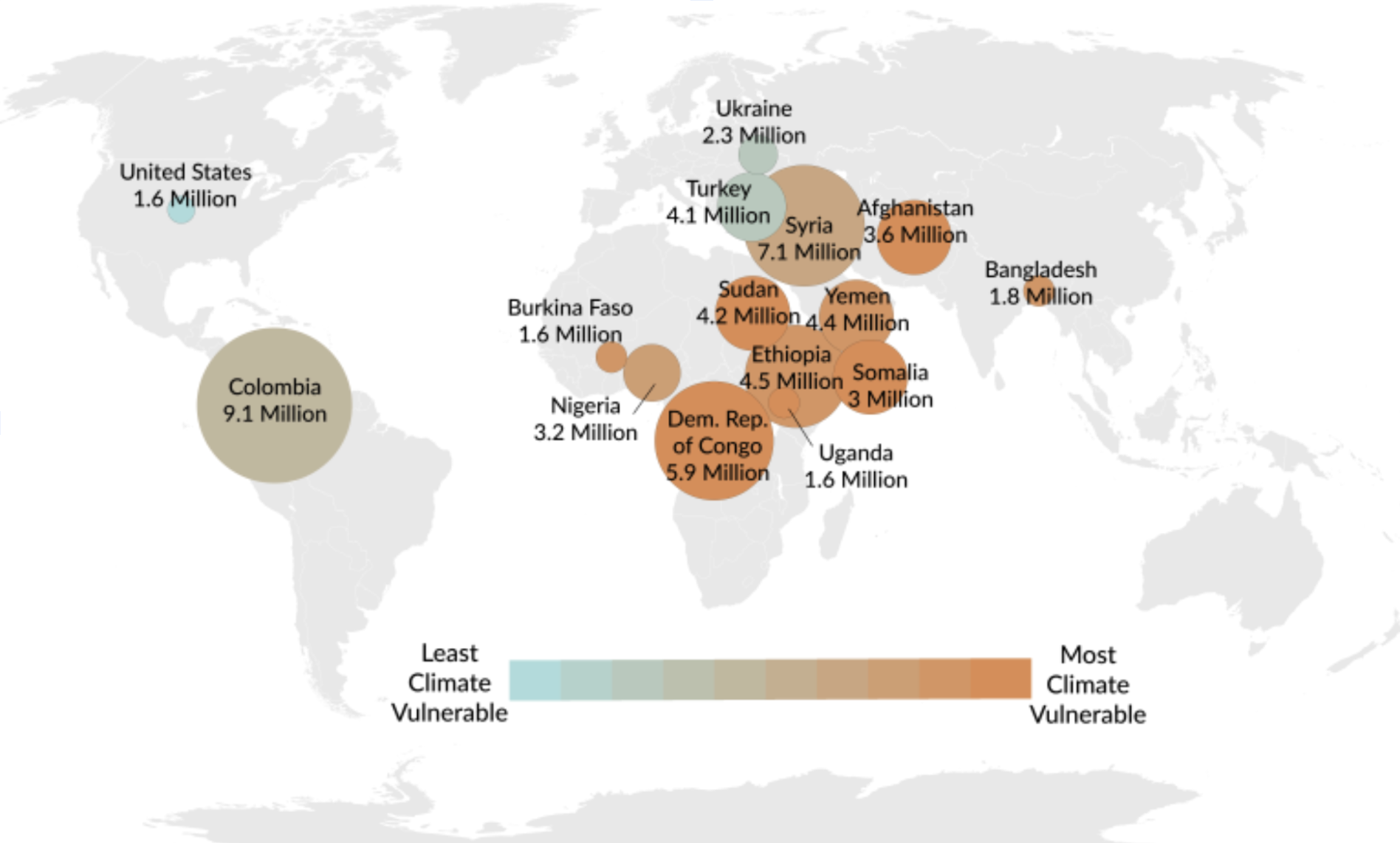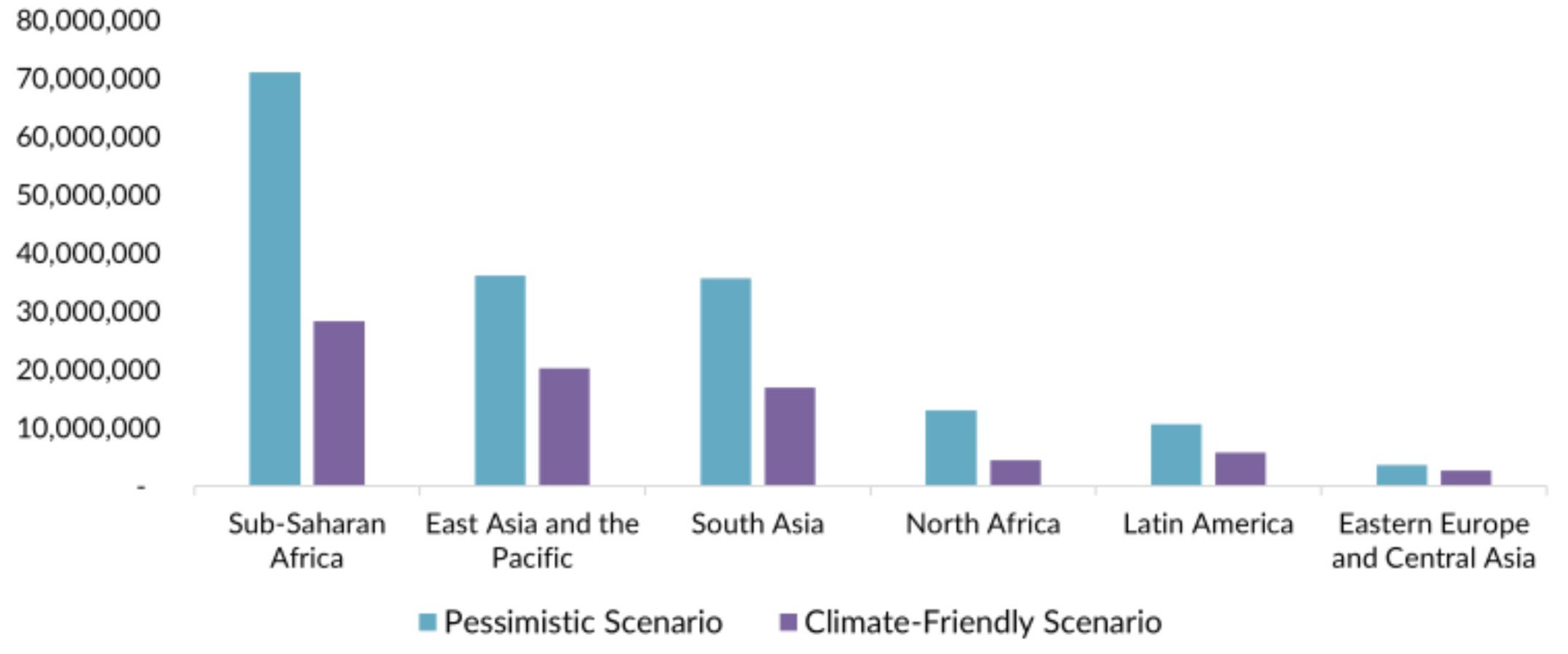Environmental Refugees
Written By: Ngoc Tran
Every year, millions of people are forced to flee their homes due to violence, human rights violations, and persecution. But did you know that climate change and environmental disasters are also one of the leading causes of displacement? As global climate changes and natural disasters become more frequent and severe, a growing number of individuals are being forced to leave their hometowns. This often overlooked category of displaced people is increasing as erratic and rapid changes in environmental patterns persist. The plight of these environmental refugees not only necessitates a more sustainable approach to humanitarian aid, but also highlights the urgent need to address the root causes of climate change and reform environmental policies.
Source: Firstpost
Background
One response to the impacts of climate change is a startling increase in the number of refugees. Climate change used to be a minor reason for people to move, but has become increasingly significant due to the increase in industrial activity, releasing too many greenhouse gasses. The increase in the amount of trapped heat results in extended droughts, greatly affecting regions that rely on agriculture. Likewise, natural disasters of all kinds cause many residents to flee. Climate migrants are those displaced by drastic changes in the environment, and such issues are often not addressed enough by the environmental policies of the regions they live in.
Causes
Climate change, driven by both natural events like volcanic eruptions and human activities such as burning fossil fuels and deforestation, has been a persistent force shaping our planet for billions of years. However, since the Industrial Revolution, the pace has accelerated dramatically. The uncontrolled release of greenhouse gases–particularly from burning coal, oil, and natural gas to power our modern world–has led to a significant rise in Earth's average temperature with no signs of slowing down.
The harsh reality is that while wealthy, industrialized countries are the main contributors to greenhouse gas emissions, it is the low-income and developing nations that bear the brunt of climate change. These vulnerable regions, often located in deserts or low-lying islands, lack the resources to prepare for or recover from climate emergencies. Rising temperatures exacerbate issues like droughts and desertification, degrading topsoil to the point where it can no longer sustain agriculture; this leads to widespread hunger as people struggle to grow enough food. National Geographic highlights this stark reality, noting that “dry-land areas affected by drought and desertification have the highest infant mortality rates and the lowest gross domestic product per capita.”
Furthermore, the impact of climate change is vividly illustrated by the devastation caused by tornadoes and floods. These natural disasters destroy homes, infrastructure, and livelihoods, forcing people to abandon their communities in search of safety and stability. Tornadoes with their ferocious winds can obliterate entire neighborhoods, leaving families homeless and bereft of essentials. Floods can submerge vast areas, ruining crops, contaminating water supplies, and rendering whole regions uninhabitable. The aftermath of such events often involves prolonged displacement, as rebuilding efforts take years and may never fully restore the affected areas. Consequently, victims of these natural catastrophes frequently become environmental refugees, compelled to seek new opportunities and safer living conditions elsewhere.
Top Humanitarian Migrant-Hosting Countries
Source: Migration Policy Institute (MPI) artist rendering based on UNHCR “Refugee Data Finder”
Impact
The United Nations reported that in 2022, a higher percentage of refugees came from areas at risk due to climate change than ever before, increasing from 61 percent in 2010 to 84 percent in 2022. A 2021 World Bank report estimated that by 2050, the climate crisis could force more than 200 million people to relocate. In 2020, the Institute for Economics and Peace projected that over one billion people could be at risk of displacement by 2050, driven by the combined threats of climate change and civil unrest.
The impact of environmental issues on migration varies by region. For instance, in El Salvador, Guatemala, and Honduras, only 6 percent of migrant-sending households cited climate- and environment-related reasons for emigration, according to a 2021 report from the World Food Program, Migration Policy Institute, and Massachusetts Institute of Technology. Similarly, in Central Africa, just 5 percent of migrants reported moving for environmental reasons, according to a Mixed Migration Centre survey published in 2022. However, when asked if the environment influenced their decision to move, 50 percent of Central African respondents agreed.
Estimated Internal Climate Migration by 2050
Source: Viviane Clement
Adults Displaced by Natural Disasters in the United States
Source: U.S. Census Bureau
Struggles
Scientists predict that if greenhouse gas emissions are not significantly reduced, sea levels in the United States could rise by as much as 2.2 meters (7.2 feet) by 2100. Rising sea levels are already causing problems in low-lying coastal areas worldwide. For example, about a third of Bangladesh's population lives along the coast, and two-thirds of the country is 4.5 meters (15 feet) or less above sea level. In 1995, rising sea levels half-submerged Bangladesh’s Bhola Island, leaving 500,000 people homeless. Rising sea levels, combined with more frequent storms and floods, will impact tens of millions of people, particularly in coastal areas and on islands. Water availability will be reduced in regions such as the Mediterranean, the Middle East, Southern Africa, and Latin America, exposing hundreds of millions to water stress. Crop yields will decrease in parts of Africa, putting additional millions at risk of hunger. The areas most affected by climate change will be Africa, the Asian mega deltas, and small islands.
Climate change leads to more frequent and severe tornadoes and floods, causing greater destruction of homes, infrastructure, and communities, and displacing more people. Floods and tornadoes destroy agricultural lands, businesses, and workplaces, leading to economic instability and forcing people to migrate in search of employment and financial security. Contaminated water supplies and poor sanitation after floods result in disease outbreaks, while trauma and inadequate medical care in displaced populations cause mental and physical health issues. Slow recovery and rebuilding processes prolong displacement periods, as there are limited resources and support in temporary shelters and refugee camps. The strain on resources such as food, clean water, and housing in host communities increases competition, potentially leading to conflict and tension. Refugees face separation from family, friends, and community support systems, social isolation, and difficulty in rebuilding social ties in new environments. Language barriers, cultural differences, and legal obstacles hinder integration; access to education, healthcare, and employment opportunities is often challenging. The trauma from experiencing and witnessing destruction and displacement, combined with anxiety and uncertainty about the future, can have a tremendous impact on one’s mental health.
This issue is underscored when according to the UN International Strategy for Disaster Reduction (ISDR), Margareta Wahlström highlighted that "over the past 30 years, disasters – storms, floods, and droughts – have increased threefold," highlighting the impact these natural disasters have on people all over the world.
In the U.S. state of Louisiana, for instance, more than 65 square kilometers (25 square miles) are lost to the sea each year, particularly along the Mississippi Delta. When fresh water from the Mississippi River mixes with saltwater from the sea, it disrupts the salinity balance in both ecosystems, killing fish and other aquatic life. Climate change issues, such as storms causing the Mississippi River to flood the ocean with fresh water or rising sea levels flooding inland freshwater with saltwater, threaten both ecosystems and the livelihoods of people dependent on the fishing industry.
Source: Boston University School of Law
Source: Boston University School of Law
Aid Efforts
Presently, a wide range of actors are involved in disaster response, including the governments of affected countries, local and national civil society organizations, UN agencies, international NGOs, donor governments, and those directly impacted by disasters. For example, Refugees International's Climate Displacement Program advocates for climate-displaced people and offers expertise on the complex relationship between extreme weather, climate change, and displacement. The Environmental Justice Foundation (EJF) helps climate refugees by working towards a more sustainable world through film and photography. Climate Refugees is an organization that raises awareness about climate refugees through field reports and social media. They gather information and meet with governments and the United Nations to prioritize policies that protect climate refugees. In 2017, they released their first field report on the connection between climate change and displacement in the Lake Chad Basin. The International Organization for Migration (IOM), an intergovernmental organization, works to ensure a migration process that recognizes human rights worldwide. Since 1998, IOM has worked on nearly 1,000 projects responding to migration due to environmental disasters. In 2015, the IOM founded the Migration, Environment, and Climate Change Division (MECC), specifically focusing on the connection between climate change and displacement.
Call to Action
Although there is growing recognition that people affected by natural disasters need our protection, significant efforts are still required to translate this acknowledgment into action on the ground. For instance, training on the Operational Guidelines should be integrated into the existing training programs of UN agencies and NGOs to ensure they are embedded in ongoing initiatives. With the adoption of the cluster approach to humanitarian response, a lead agency should be appointed to oversee the protection of those impacted by natural disasters. The UN resident representative or humanitarian coordinator should consult with UNHCR, UNICEF, and OHCHR to identify which agency is best suited to assume responsibility for protection in a specific situation. However, agencies are concerned about their capacity to take on additional responsibilities and the potential dilution of their traditional mandates.
Every voice counts, including yours! If we collectively call for action and advocate for more sustainable environmental practices, we can prevent the displacement of vulnerable populations who unfairly suffer the consequences of environmental exploitation by the wealthy. Together, we can make a difference.
Sources
https://borgenproject.org/organizations-helping-climate-refugees/
https://education.nationalgeographic.org/resource/environmental-refugee/
https://education.nationalgeographic.org/resource/environmental-refugee/
https://www.brookings.edu/articles/displacement-natural-disasters-and-human-rights/
https://www.brookings.edu/articles/displacement-natural-disasters-and-human-rights/
https://www.migrationpolicy.org/article/climate-migration-101-explainer
https://www.migrationpolicy.org/article/climate-migration-101-explainer





